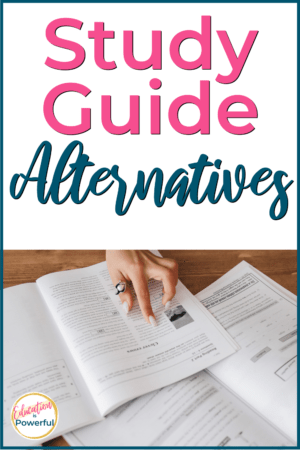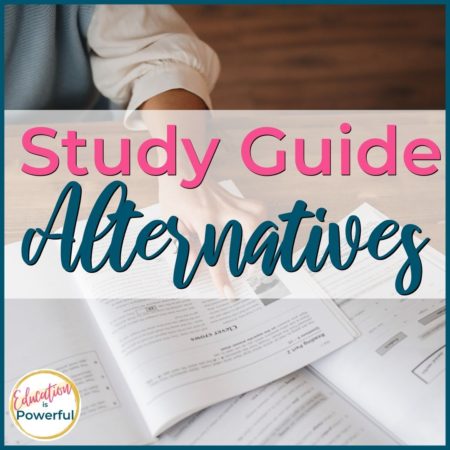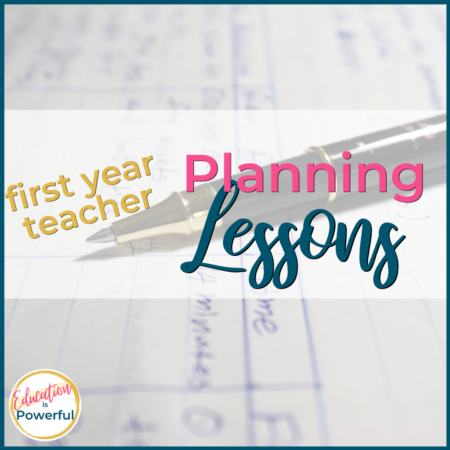Table of Contents
I know that in the past, I have gotten into a rut with my daily assignments and have looked for alternatives to a study guide. Have you? Study guide alternatives can help engage our students and challenge them in new and different ways. Even study guide options allow students to synthesize and evaluate during the task that traditional questions and answer study guides can’t do.
I’ll never forget my middle school, social studies class. I had the same teacher for three years and every single day we did the same thing. She would hand out a packet with study guide questions. And then she would turn on Enya and we would open up our textbooks and copy answers out of the textbook. Period.
Now, I loved this teacher because she would sit and talk to us and I felt like she really cared about us. But I can’t say I remember a single thing about anything from any of my social studies classes for the three years of middle school. It was a real easy-A type of class, but no real deep learning happened. So, first, let’s talk about what a study guide is and then I will give you examples of some study guide alternatives.
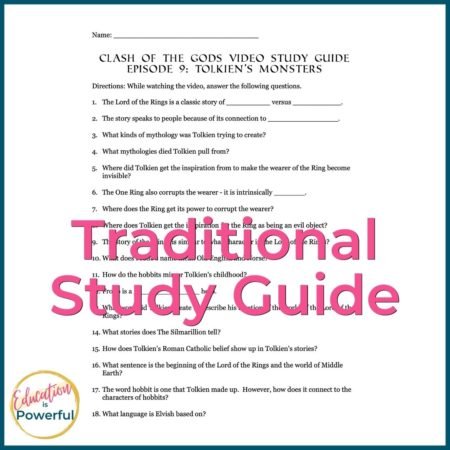 You can also see this when you do a PowerPoint presentation and students are writing down notes from your PowerPoint slides. It doesn’t matter how many times you say, “Just get the key details.” Students still want a copy down everything word for word. And so you end up after every slide with this long dramatic pause. And you’ll always have that one kid who can never quite finish the slide.
We use these in our classrooms. Not because we’re actively teaching students, but we’re trying to hold them accountable for the information.
I’ve used them in the past. I still use them. Sometimes it’s the most effective way to have students get notes down.
Most study guides are a DOK level one. They very rarely include any analysis or synthesis. It’s merely a way of conveying and checking for information.
I think it’s really important that we give alternatives to study guides because study guides don’t encourage deep learning. They don’t encourage synthesis. They don’t encourage evaluation. When I think about what I want to teach my students, I want them to be critical thinkers. And a study guide with just questions and answers doesn’t really help them become a critical thinker.
You can also see this when you do a PowerPoint presentation and students are writing down notes from your PowerPoint slides. It doesn’t matter how many times you say, “Just get the key details.” Students still want a copy down everything word for word. And so you end up after every slide with this long dramatic pause. And you’ll always have that one kid who can never quite finish the slide.
We use these in our classrooms. Not because we’re actively teaching students, but we’re trying to hold them accountable for the information.
I’ve used them in the past. I still use them. Sometimes it’s the most effective way to have students get notes down.
Most study guides are a DOK level one. They very rarely include any analysis or synthesis. It’s merely a way of conveying and checking for information.
I think it’s really important that we give alternatives to study guides because study guides don’t encourage deep learning. They don’t encourage synthesis. They don’t encourage evaluation. When I think about what I want to teach my students, I want them to be critical thinkers. And a study guide with just questions and answers doesn’t really help them become a critical thinker.
 This is the graphic organizer I use for my political cartoon analysis. Which you can download for free. (If you are looking for tips on teaching controversial political texts, check out the blog post.)
When students can organize their thoughts, it’s easier for them to go back, make connections, and delve deeper. So there is a reason to have a DOK 1 type of study guide alternative. You can’t do analysis or synthesis, which is DOK 4, without DOK 1. Right? We need to build up to that.
Another good alternative to a study guide is to allow for doodle notes. And you will see these in a wide variety out there from straight drawings or blank pages where students decide the structure and fill it in with words or images.
You might also see them. In the form of a structured, doodle note, which is what I prefer to use with my students. Often students might not know what the most important thing is that they should be taking notes on so we can help them with that by providing that structure.
Another great benefit to using study guide alternatives is it encourages students to make connections. They’re not just writing down answers to questions, but alternatives can really create synthesis and build connections for students, which then helps them remember things more. Then you can have deeper learning around whatever topic you’re teaching.
And then of course the last study guide alternatives are activities. I define these as options that can be used many times in the course of a unit and referred back to many times. It’s something that you’re going back to and you’re building on. And it’s a structure that allows students to grow in their learning or change their thinking over the course of a text.
This is the graphic organizer I use for my political cartoon analysis. Which you can download for free. (If you are looking for tips on teaching controversial political texts, check out the blog post.)
When students can organize their thoughts, it’s easier for them to go back, make connections, and delve deeper. So there is a reason to have a DOK 1 type of study guide alternative. You can’t do analysis or synthesis, which is DOK 4, without DOK 1. Right? We need to build up to that.
Another good alternative to a study guide is to allow for doodle notes. And you will see these in a wide variety out there from straight drawings or blank pages where students decide the structure and fill it in with words or images.
You might also see them. In the form of a structured, doodle note, which is what I prefer to use with my students. Often students might not know what the most important thing is that they should be taking notes on so we can help them with that by providing that structure.
Another great benefit to using study guide alternatives is it encourages students to make connections. They’re not just writing down answers to questions, but alternatives can really create synthesis and build connections for students, which then helps them remember things more. Then you can have deeper learning around whatever topic you’re teaching.
And then of course the last study guide alternatives are activities. I define these as options that can be used many times in the course of a unit and referred back to many times. It’s something that you’re going back to and you’re building on. And it’s a structure that allows students to grow in their learning or change their thinking over the course of a text.
 Here’s another example using my doodle notes for the Greeking Out podcast. Students will summarize and they do have more formal pieces on the front of the worksheet, but then on the back, they get to draw or sketch. They’re thinking about the major elements of the myth.
Here’s another example using my doodle notes for the Greeking Out podcast. Students will summarize and they do have more formal pieces on the front of the worksheet, but then on the back, they get to draw or sketch. They’re thinking about the major elements of the myth.
 Try this one for Jason and the Quest for the Golden Fleece here. If you want to learn why you should use podcasts in your class read the blog post all about it, with some of my favorite podcasts to use in my class.
Try this one for Jason and the Quest for the Golden Fleece here. If you want to learn why you should use podcasts in your class read the blog post all about it, with some of my favorite podcasts to use in my class.
 Click here to download my freebie for Tolkein’s Monsters.
Click here to download my freebie for Tolkein’s Monsters.
 PS – Flesh and Blood So Cheap is a great nonfiction text to pair with Uprising by Margaret Peterson Haddix.
PS – Flesh and Blood So Cheap is a great nonfiction text to pair with Uprising by Margaret Peterson Haddix.
 Students choose a theme, motif, symbol, and character to focus on while reading a longer text. As they read they are gathering quotes that are examples of what they have chosen and write a mini-analysis explaining how their quote connects to the larger idea (theme, for example). This type of extended activity helps students prepare for a deep analysis of a text and make connections across several literary elements. I use this in preparation for a Socratic seminar or literary analysis essay. Students have all the relevant quotes gathered and the explanation/expounding section of their quote analysis completed.
You can get a free one for The Great Gatsby here. Or check out all the ones that I’ve made for a variety of novels here.
In these activities for The Taming of the Shrew, students have activities for the entire act. Students are filling this out and completing this either while reading or at the end. It really helps them synthesize everything that they’ve read in the act and start making connections.
Students choose a theme, motif, symbol, and character to focus on while reading a longer text. As they read they are gathering quotes that are examples of what they have chosen and write a mini-analysis explaining how their quote connects to the larger idea (theme, for example). This type of extended activity helps students prepare for a deep analysis of a text and make connections across several literary elements. I use this in preparation for a Socratic seminar or literary analysis essay. Students have all the relevant quotes gathered and the explanation/expounding section of their quote analysis completed.
You can get a free one for The Great Gatsby here. Or check out all the ones that I’ve made for a variety of novels here.
In these activities for The Taming of the Shrew, students have activities for the entire act. Students are filling this out and completing this either while reading or at the end. It really helps them synthesize everything that they’ve read in the act and start making connections.
 These types of activities really help students see a bigger picture and really see the connections between different scenes, different characters, or different elements that are happening in the play. It also helps us make connections to a greater purpose, such as, how you view gender?
If you want to check out my free set of Act One reading activities, feminism/gender activities, and study guides for Taming of the Shrew, You can download all of that in the description of my Taming of the Shrew Unit.
So I challenge you to break away from your traditional study guides and try one of these study guide alternatives. Create some variety for your students and put the power back in your students’ hands. Let them really dive into texts. Explore them. Live and breathe in them. Make connections and evaluate them. You will see this impact their learning tremendously.
These types of activities really help students see a bigger picture and really see the connections between different scenes, different characters, or different elements that are happening in the play. It also helps us make connections to a greater purpose, such as, how you view gender?
If you want to check out my free set of Act One reading activities, feminism/gender activities, and study guides for Taming of the Shrew, You can download all of that in the description of my Taming of the Shrew Unit.
So I challenge you to break away from your traditional study guides and try one of these study guide alternatives. Create some variety for your students and put the power back in your students’ hands. Let them really dive into texts. Explore them. Live and breathe in them. Make connections and evaluate them. You will see this impact their learning tremendously.

What is a Study Guide?
Usually, study guides are teacher-created questions that align with a text, video, or presentation. Students will read the text or watch the video to find the answers to the questions while they’re reading/viewing. From my experience, students have a hard time synthesizing that information and putting it into their own words. So they will copy everything down word for word or try to get exactly what the video said. You know, you’ve passed out a study guide, if while you’re watching a video, students are whispering to each other in order to get the exact right answer to your question. That’s a study guide. You can also see this when you do a PowerPoint presentation and students are writing down notes from your PowerPoint slides. It doesn’t matter how many times you say, “Just get the key details.” Students still want a copy down everything word for word. And so you end up after every slide with this long dramatic pause. And you’ll always have that one kid who can never quite finish the slide.
We use these in our classrooms. Not because we’re actively teaching students, but we’re trying to hold them accountable for the information.
I’ve used them in the past. I still use them. Sometimes it’s the most effective way to have students get notes down.
Most study guides are a DOK level one. They very rarely include any analysis or synthesis. It’s merely a way of conveying and checking for information.
I think it’s really important that we give alternatives to study guides because study guides don’t encourage deep learning. They don’t encourage synthesis. They don’t encourage evaluation. When I think about what I want to teach my students, I want them to be critical thinkers. And a study guide with just questions and answers doesn’t really help them become a critical thinker.
You can also see this when you do a PowerPoint presentation and students are writing down notes from your PowerPoint slides. It doesn’t matter how many times you say, “Just get the key details.” Students still want a copy down everything word for word. And so you end up after every slide with this long dramatic pause. And you’ll always have that one kid who can never quite finish the slide.
We use these in our classrooms. Not because we’re actively teaching students, but we’re trying to hold them accountable for the information.
I’ve used them in the past. I still use them. Sometimes it’s the most effective way to have students get notes down.
Most study guides are a DOK level one. They very rarely include any analysis or synthesis. It’s merely a way of conveying and checking for information.
I think it’s really important that we give alternatives to study guides because study guides don’t encourage deep learning. They don’t encourage synthesis. They don’t encourage evaluation. When I think about what I want to teach my students, I want them to be critical thinkers. And a study guide with just questions and answers doesn’t really help them become a critical thinker.
What are the benefits of using study guide alternatives?
Using different structures or study guide alternatives can really help students actually organize their thoughts. These are most commonly done with graphic organizers.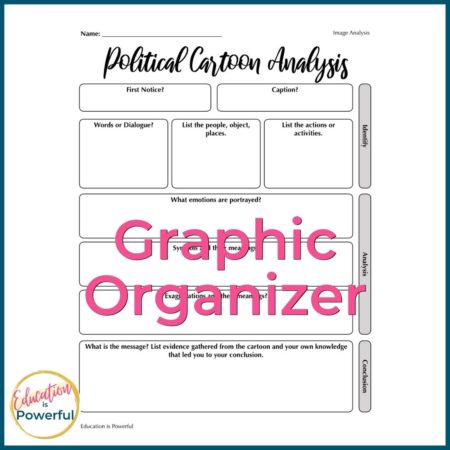 This is the graphic organizer I use for my political cartoon analysis. Which you can download for free. (If you are looking for tips on teaching controversial political texts, check out the blog post.)
When students can organize their thoughts, it’s easier for them to go back, make connections, and delve deeper. So there is a reason to have a DOK 1 type of study guide alternative. You can’t do analysis or synthesis, which is DOK 4, without DOK 1. Right? We need to build up to that.
Another good alternative to a study guide is to allow for doodle notes. And you will see these in a wide variety out there from straight drawings or blank pages where students decide the structure and fill it in with words or images.
You might also see them. In the form of a structured, doodle note, which is what I prefer to use with my students. Often students might not know what the most important thing is that they should be taking notes on so we can help them with that by providing that structure.
Another great benefit to using study guide alternatives is it encourages students to make connections. They’re not just writing down answers to questions, but alternatives can really create synthesis and build connections for students, which then helps them remember things more. Then you can have deeper learning around whatever topic you’re teaching.
And then of course the last study guide alternatives are activities. I define these as options that can be used many times in the course of a unit and referred back to many times. It’s something that you’re going back to and you’re building on. And it’s a structure that allows students to grow in their learning or change their thinking over the course of a text.
This is the graphic organizer I use for my political cartoon analysis. Which you can download for free. (If you are looking for tips on teaching controversial political texts, check out the blog post.)
When students can organize their thoughts, it’s easier for them to go back, make connections, and delve deeper. So there is a reason to have a DOK 1 type of study guide alternative. You can’t do analysis or synthesis, which is DOK 4, without DOK 1. Right? We need to build up to that.
Another good alternative to a study guide is to allow for doodle notes. And you will see these in a wide variety out there from straight drawings or blank pages where students decide the structure and fill it in with words or images.
You might also see them. In the form of a structured, doodle note, which is what I prefer to use with my students. Often students might not know what the most important thing is that they should be taking notes on so we can help them with that by providing that structure.
Another great benefit to using study guide alternatives is it encourages students to make connections. They’re not just writing down answers to questions, but alternatives can really create synthesis and build connections for students, which then helps them remember things more. Then you can have deeper learning around whatever topic you’re teaching.
And then of course the last study guide alternatives are activities. I define these as options that can be used many times in the course of a unit and referred back to many times. It’s something that you’re going back to and you’re building on. And it’s a structure that allows students to grow in their learning or change their thinking over the course of a text.
Examples of Study Guide Alternatives
So I want to give you some examples of things that I’ve done in my classroom that are these alternatives to the traditional study guide.1. Doodle Notes
You can see here, I’ve used this with a novel study for each chapter in Whirligig students get a doodle note sheet that they can work on while we’re reading or after your reading. Here’s another example using my doodle notes for the Greeking Out podcast. Students will summarize and they do have more formal pieces on the front of the worksheet, but then on the back, they get to draw or sketch. They’re thinking about the major elements of the myth.
Here’s another example using my doodle notes for the Greeking Out podcast. Students will summarize and they do have more formal pieces on the front of the worksheet, but then on the back, they get to draw or sketch. They’re thinking about the major elements of the myth.
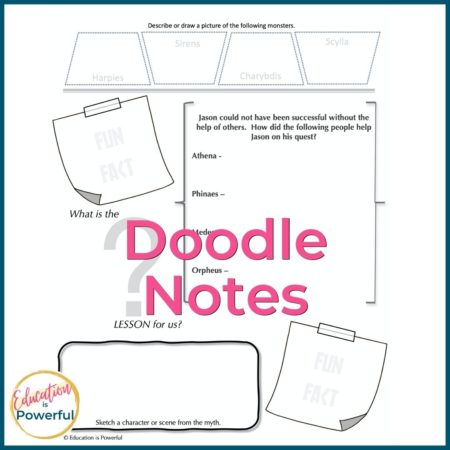 Try this one for Jason and the Quest for the Golden Fleece here. If you want to learn why you should use podcasts in your class read the blog post all about it, with some of my favorite podcasts to use in my class.
Try this one for Jason and the Quest for the Golden Fleece here. If you want to learn why you should use podcasts in your class read the blog post all about it, with some of my favorite podcasts to use in my class.
2. Note Squares
The second example I want to give you is notes squares for my Clash of the Gods video study guides. I have traditional Q and A for these (see picture above), but I also have these note squares, and this is what I use most frequently. At the top of the note square students are given the topic or a guiding question. And then as they’re watching the video, they answer that question. The topic of the note square might be over the course of 5 to 10 minutes in the video. Students have to decide what’s most important because they have a limited amount of space to write their notes in. Click here to download my freebie for Tolkein’s Monsters.
Click here to download my freebie for Tolkein’s Monsters.
3. Graphic Organizers
Next here’s an example of a graphic organizer. I use these graphic organizers when teaching Flesh and Blood So Cheap. This is a non-fiction text that is dense with information. The graphic organizers help students gather important information and organize it in a logical way.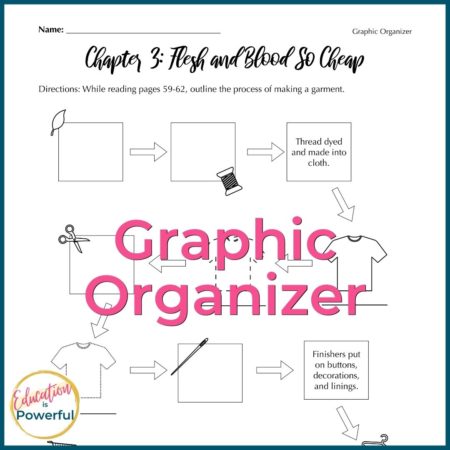 PS – Flesh and Blood So Cheap is a great nonfiction text to pair with Uprising by Margaret Peterson Haddix.
PS – Flesh and Blood So Cheap is a great nonfiction text to pair with Uprising by Margaret Peterson Haddix.
4. Extended Activities
And the last type of study guide alternatives are activities that I use the most with novels or plays. Here’s an example of an activity that I use for a whole novel that teaches literary analysis.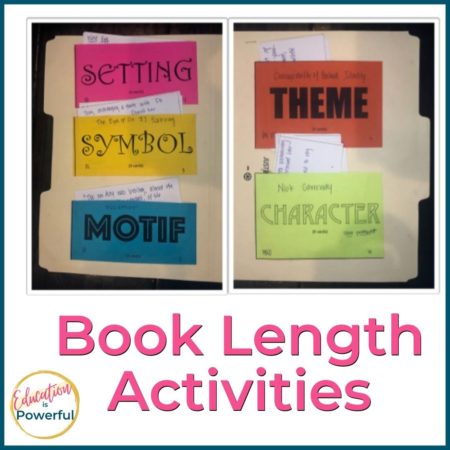 Students choose a theme, motif, symbol, and character to focus on while reading a longer text. As they read they are gathering quotes that are examples of what they have chosen and write a mini-analysis explaining how their quote connects to the larger idea (theme, for example). This type of extended activity helps students prepare for a deep analysis of a text and make connections across several literary elements. I use this in preparation for a Socratic seminar or literary analysis essay. Students have all the relevant quotes gathered and the explanation/expounding section of their quote analysis completed.
You can get a free one for The Great Gatsby here. Or check out all the ones that I’ve made for a variety of novels here.
In these activities for The Taming of the Shrew, students have activities for the entire act. Students are filling this out and completing this either while reading or at the end. It really helps them synthesize everything that they’ve read in the act and start making connections.
Students choose a theme, motif, symbol, and character to focus on while reading a longer text. As they read they are gathering quotes that are examples of what they have chosen and write a mini-analysis explaining how their quote connects to the larger idea (theme, for example). This type of extended activity helps students prepare for a deep analysis of a text and make connections across several literary elements. I use this in preparation for a Socratic seminar or literary analysis essay. Students have all the relevant quotes gathered and the explanation/expounding section of their quote analysis completed.
You can get a free one for The Great Gatsby here. Or check out all the ones that I’ve made for a variety of novels here.
In these activities for The Taming of the Shrew, students have activities for the entire act. Students are filling this out and completing this either while reading or at the end. It really helps them synthesize everything that they’ve read in the act and start making connections.
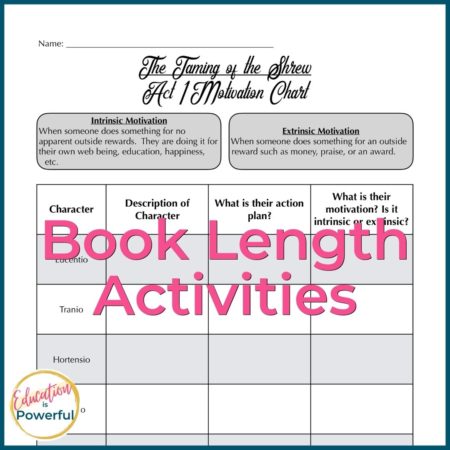 These types of activities really help students see a bigger picture and really see the connections between different scenes, different characters, or different elements that are happening in the play. It also helps us make connections to a greater purpose, such as, how you view gender?
If you want to check out my free set of Act One reading activities, feminism/gender activities, and study guides for Taming of the Shrew, You can download all of that in the description of my Taming of the Shrew Unit.
So I challenge you to break away from your traditional study guides and try one of these study guide alternatives. Create some variety for your students and put the power back in your students’ hands. Let them really dive into texts. Explore them. Live and breathe in them. Make connections and evaluate them. You will see this impact their learning tremendously.
These types of activities really help students see a bigger picture and really see the connections between different scenes, different characters, or different elements that are happening in the play. It also helps us make connections to a greater purpose, such as, how you view gender?
If you want to check out my free set of Act One reading activities, feminism/gender activities, and study guides for Taming of the Shrew, You can download all of that in the description of my Taming of the Shrew Unit.
So I challenge you to break away from your traditional study guides and try one of these study guide alternatives. Create some variety for your students and put the power back in your students’ hands. Let them really dive into texts. Explore them. Live and breathe in them. Make connections and evaluate them. You will see this impact their learning tremendously.
